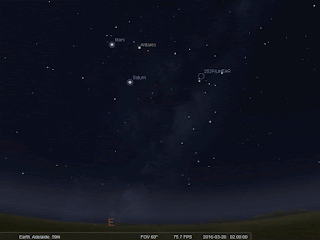Friday, March 25, 2016
Comet 252P Amongst the Clusters of Scorpius and Ophiuchus (25 March - 1 April)
The is good news and bad news about Comet 252P.
Animation of the comets path through the sky from 26-30 March at 2 am.
Good news: It has passed its closest approach to Earth and is still bright. While potentially (just) visible to the unaided eye, the bright Moonlight means that it will be a binocular or telescope object for most people.
From the 25th to 30th March 252P will be in a cluster and nebula rich region in between the Scorpion's tail and Ophiuchus. There are so many potential objects it is nearby that it would take ages to list them, and a binocular scan will bring delight at every view.
The most notable encounter is one on the 27th when the comet is within 2 degrees of the Butterfly cluster (M6) and 5 degrees from Ptolmey's cluster, with many smaller clusters closer. At this time the comet is rising around 10:30-11:30 pm in Australia, but the best time to observe is from around 2-3 am on, when the comet has cleared the murk of the horizon. In the Northern Hemisphere, the comet should now be visible above the horizon around Astronomical twilight in the morning.
Bad news: Unfortunately, while the Moon is waning (Yay) it is close the 252P for most of this time, less than 40 degrees from the the comet on the 27th, and comes closer as the days progress. It is also rising before, or just after the comet. So we get no relief from Moonlight. You will definitely need to dark adapt your eyes to have a good chance to see the comet.
The Moon is within 6 degrees (a hand-span) from the comet on the 30th and 31st. This will make the comet extraordinarily difficult, if not impossible, to see, with ordinary binoculars and telescopes.
If you have a telescope with narrowband filters imaging will probably be okay up to 29-31 March, the even though waning the Moon will be sufficiently close to significantly interfere.
Printable PDF versions of the above maps, spotters chart and binocular chart at 3:00 pm ACDST. Use a red torch, or a normal torch with red cellphane over the end so as to not destroy your night vision. For more help with dark adaptation see here.
More good news: There are good guide stars now. tonight/early morning 26th the two stars that form the sting of the Scorpions tail, Lesath and Shalula, point to the comet. On the 27th the comet is above M6, the butterfly cluster, which is obvious in binoculars. On the 28th, star hopping down two from bright Theta Ophiuchus will bring you to the comet.
Labels: 252P, binocular, comet, telescope









 Click to read about or order
Click to read about or order Click to read about or order
Click to read about or order Click to read about or order
Click to read about or order Click to read about or order
Click to read about or order




